
Quebec in October.
Part 2. Low-diversity forests.
Some forests of the North offer another kind of fall coloration.
Their colors are created by just a few species of trees, but these species are
either highly variable, or particularly bright. Many of the world's most impressive
places to see them are not glacial refugia at all - they've been colonized by
deciduous forests only recently.

Red maple-dominated forest, La
Mauricie Nat'l Park, Quebeck. |

Maple forest, Gatineau Park, Ontario.
The most spectacular fall colors on our planet are those of New England and Eastern
Canada. They are mostly created by two species of maples - red (Acer rubrum)
and sugar (A. saccharum). |

Sugar maple-dominated forest,
Algonquin Prov. Park, Ontario. |
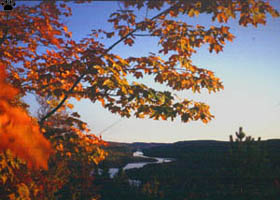
La Mauricie Nat'l Park, Quebec. |
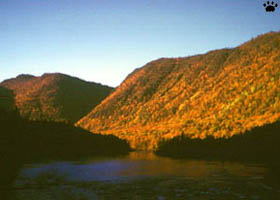
Jacques-Cartier Prov. Park, Quebec. |


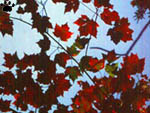
Leaves of sugar maples. |
Red maple dominates in coastal New England, the Maritimes,
Quebec, and Eastern Ontario at low elevations. Sugar maple is more hardy, and
forms pure stands in many places between New York and Winnipeg, often high in
the mountains. Ironically, some popular leaf-viewing destinations, such as Ontario's
Algonquin Park and New Hempshire's White Mountains, have mostly sugar maples,
so the forests there turn yellow rather than red. Quebec's La Mauricie Nat'l Park
is a good place to see red maple forests.

Sometimes sugar maple also turns red, not yellow. |
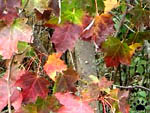
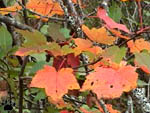
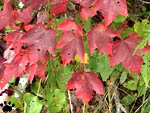
Leaves of red maples. |

Adult red maple, New Brunswick. |
In addition to red and sugar maples,
four more species of maples, and many other deciduous trees, occur in the area,
but they don't play such an important role in creating the fall colors.
Fallen leaves, Ohio. |
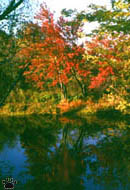
Young red maple, Maine. |
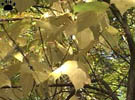
|
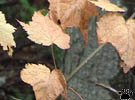
|
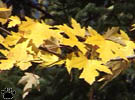
|
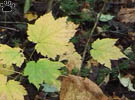
|
| Maples of Eastern Canada, left to right:
black (A. nigrum), striped (A. pennsylvanicum), silver (A. saccharinum),
mountain (A. spicatum). |

Maples in Columbia River Gorge,
USA. |
In the Pacific Northwest of North America,
good fall colors can only be seen once in few years because of mild climate, but
when they do occur, they are created almost entirely by vine and bigleaf maples
(A. circinatum, A. macrophyllum). In dry Ulytau mountains of central Kazakhstan,
the only tree present is boxelder (A. negundo), introduced from North America,
but its groves can be very beautiful. |

Boxelder, Ulytau Mountains,
Kazakhstan. |

Maple-oak forest, near Salt Lake,
Utah, USA. |

Mongolian oaks, Russian-Chinese border.
Each September, oak Quercus mongolicus turns plains and hills of upper
Amur basin into a splendid display of brown, chocolate, tan and yellow. |

Mongolian oaks, Greater Khingan
Mts., China. |
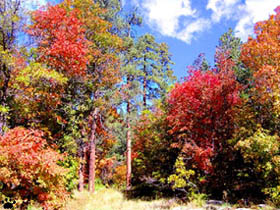
Rocky Mountains maples, Tajique Canyon, New Mexico. |
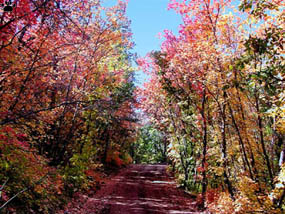
Rocky Mountains maples, Tajique Canyon, New Mexico. |

Maples in Uinta Mts., USA. |
Some forests of the Rocky Mountains
are turned into a sea of fire by Rocky Mountain maple (A. glabrum) and
Gambell's oak (Q. gambelii). Both are usually small trees or large shrubs,
but can be very beautiful. |

Maples in Uinta Mts., USA. |
 |
 |
| Rocky Mountains maples, Uinta Mts.,
Utah. |
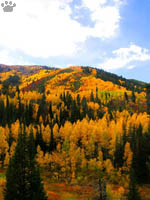
Fir-aspen forest with maples,
Uinta Mts., Utah. |
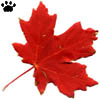
Leaf of Rocky Mountain maple.
Usually, maples in the Rockies are confined to protected canyons, but in the mountains
around Salt Lake City, Utah, they form extensive forests. |
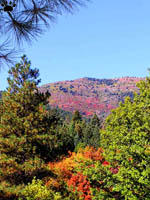
Pine forest with maples,
Tajique Canyon, New Mexico. |
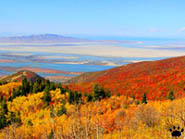 |
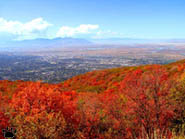 |
 |
| Vews of Salt Lake from Uinta Mts.,
Utah. |
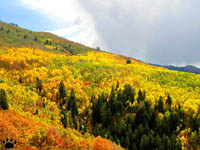
Forests of Uinta Mts. |
Maples and oaks are joined by quacking
aspen (Populus tremuloides) and conifers at higher elevations, and by Fremont's
cottonwoods (P. fremontii) along rivers. The best time to visit the Uintas
is early October. |

Aspens in Uinta Mts. |
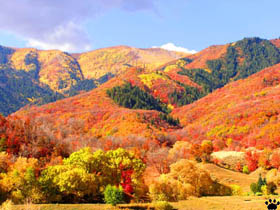
Maples, oaks, aspens, cottonwoods and firs, Uinta Mts. |
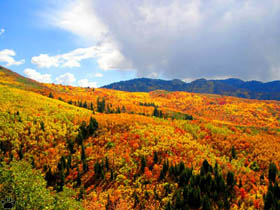
Maples, oaks, aspens, firs, and spruces, Uinta Mts.. |

Oaks, Michigan. |
Thanks to oaks, brown is the main color
of the fall in large portion of North America: the Great Lakes region, Mississippi
and Missouri valleys, and the eastern Great Plains. |

Oaks, Wisconsin. |
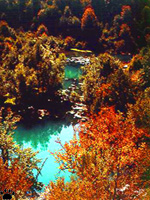
European hornbeams (Caprinus
betula), Trakai, Lithuania. |
Most European forests also own their fall beauty
to a few species of maples and oaks, joined by European linden, European beech
(Fagus sylvatica), and others.

European lindens (Tilia europea),
Saaremaa, Estonia. |

English oaks (Quercus robur),
Crimean Nature Reserve, Ukraine. |
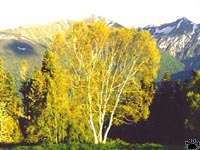
European white birch (B. pendula), Caucasus.

Stone birches (B. ermani), Milkovo, Kamchatka.
|
On the plains of Eastern Europe and Western Siberia,
fall colors are dominated by birches Betula pendula and B. pubescens.
Splendid birch forests also exist in Scandinavia and Kamchatka.
Various birch species grow at timberline of most Eurasian mountains, from the
Pyrenees to Japan and from Taimyr to the Himalayas. Not all of them have white
bark, but almost all turn yellow in the fall. |
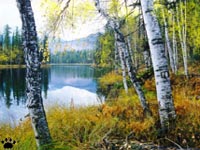
Eurasian white birch (B. pubescens), Tuva.
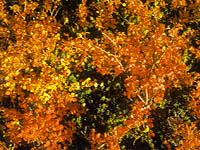
Lapland birches (B. tortuosa), Kolsky Peninsula.
|
 |
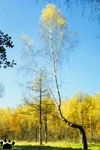 |
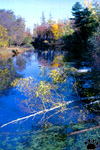 |
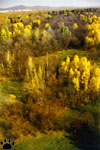 |
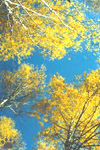 |
| Early October in Northern
Russia. |
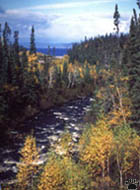
View of Lake Melville, Labrador. |

Forests of Eastern Labrador.
In North America, birches are less widespread. They dominate the fall colors of
eastern Labrador Peninsula and a few places in Alaska. |
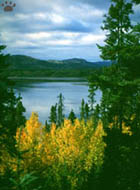
View of Lake Melville, Labrador. |
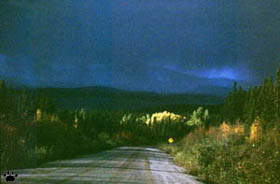
October storm on Trans-Labrador Highway. |
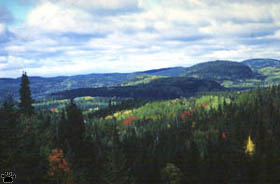
In parts of Labrador, larches and maples can be seen together.. |
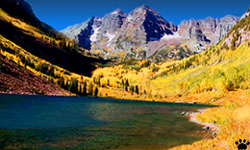 |
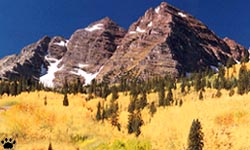 |
| In the Rocky Mountains,
the best-known site for fall colors is Aspen, Colorado, with its forests of quacking
aspen (Populus tremuloides) . |

October view of Mt. Whitney, California. |
In the Sierra Nevada of California,
there are two seasons of fall colors. In early October, eastern side and timberline
are painted with splashes of yellow and orange by quaking aspen and various bushes. |

October view of Mt. Whitney, California. |

Aspens at Monitor Pass,
California, USA. |
Then in mid-November, oaks on lower
slopes of the western side turn golden, brown and red. Between these two areas,
there is a broad belt of evergreen conifers. Oak colors are even better in the
area around Mount Shasta, between Sierra Nevada and Cascades range. Blue (Q.
douglasii), Oregon white (Q. garryana), California black (Q. kelloggii)
and valley (Q. lobata) oaks create this beautiful mix. Each species has
its own preferred habitat, so the proportions of the mix vary with altitude, slope
orientation and soil quality. |
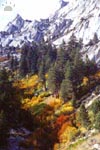
Timberline at Whitney
Portal, California. |
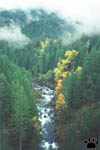
Fir-pine belt at Calaveras
River, California. |

Oak forest, Trinity
Mountains, California. |
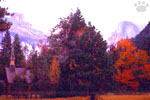
Pine-oak forest, Yosemite Valley,
California. |
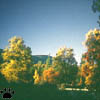
Oak woodland, Lake
Almanor, California. |
In other parts of California, evergreen species
of oaks (Q. agrifolia, Q. chrysolepis, Q. wislizeni, Q. dumosa, Q. dunni
etc.) are more common, so there are usually no fall colors to speak of.
|

Oak woodland, east from
Mt. Shasta, California. |

Leaves of Chilean trees, natural size: 1 - lenga (Notofagus pumilio),
2 - nire (N. antarcticus), 3 - roble (N. glauca), 4 - michay (Berberis
ilicifolia), 5 - lingue (Persea lingue), 6 - notro (Embothrium coccineum).
Terra del Fuego. |

Nothofagus pumilio,
Chaiten, Chile |
If you want to see the fall colors in April,
try Southern Hemisphere. Forests of Chile are probably the best place. Various
species of Southern beech (Nothofagus) have small leaves, but their colors
are very bright and clear. |

N. antarcticus,
Terra del Fuego. |
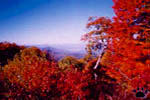
Nothofagus forest, Terra del Fuego.
Part 3. Coniferous forests
Back to Part 1
Home
|











































































